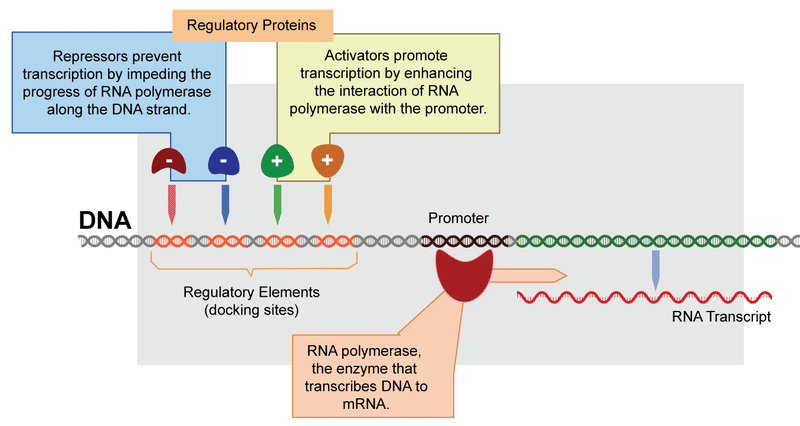4.2: Gene Expression
- Page ID
- 12089
\( \newcommand{\vecs}[1]{\overset { \scriptstyle \rightharpoonup} {\mathbf{#1}} } \)
\( \newcommand{\vecd}[1]{\overset{-\!-\!\rightharpoonup}{\vphantom{a}\smash {#1}}} \)
\( \newcommand{\dsum}{\displaystyle\sum\limits} \)
\( \newcommand{\dint}{\displaystyle\int\limits} \)
\( \newcommand{\dlim}{\displaystyle\lim\limits} \)
\( \newcommand{\id}{\mathrm{id}}\) \( \newcommand{\Span}{\mathrm{span}}\)
( \newcommand{\kernel}{\mathrm{null}\,}\) \( \newcommand{\range}{\mathrm{range}\,}\)
\( \newcommand{\RealPart}{\mathrm{Re}}\) \( \newcommand{\ImaginaryPart}{\mathrm{Im}}\)
\( \newcommand{\Argument}{\mathrm{Arg}}\) \( \newcommand{\norm}[1]{\| #1 \|}\)
\( \newcommand{\inner}[2]{\langle #1, #2 \rangle}\)
\( \newcommand{\Span}{\mathrm{span}}\)
\( \newcommand{\id}{\mathrm{id}}\)
\( \newcommand{\Span}{\mathrm{span}}\)
\( \newcommand{\kernel}{\mathrm{null}\,}\)
\( \newcommand{\range}{\mathrm{range}\,}\)
\( \newcommand{\RealPart}{\mathrm{Re}}\)
\( \newcommand{\ImaginaryPart}{\mathrm{Im}}\)
\( \newcommand{\Argument}{\mathrm{Arg}}\)
\( \newcommand{\norm}[1]{\| #1 \|}\)
\( \newcommand{\inner}[2]{\langle #1, #2 \rangle}\)
\( \newcommand{\Span}{\mathrm{span}}\) \( \newcommand{\AA}{\unicode[.8,0]{x212B}}\)
\( \newcommand{\vectorA}[1]{\vec{#1}} % arrow\)
\( \newcommand{\vectorAt}[1]{\vec{\text{#1}}} % arrow\)
\( \newcommand{\vectorB}[1]{\overset { \scriptstyle \rightharpoonup} {\mathbf{#1}} } \)
\( \newcommand{\vectorC}[1]{\textbf{#1}} \)
\( \newcommand{\vectorD}[1]{\overrightarrow{#1}} \)
\( \newcommand{\vectorDt}[1]{\overrightarrow{\text{#1}}} \)
\( \newcommand{\vectE}[1]{\overset{-\!-\!\rightharpoonup}{\vphantom{a}\smash{\mathbf {#1}}}} \)
\( \newcommand{\vecs}[1]{\overset { \scriptstyle \rightharpoonup} {\mathbf{#1}} } \)
\( \newcommand{\vecd}[1]{\overset{-\!-\!\rightharpoonup}{\vphantom{a}\smash {#1}}} \)
\(\newcommand{\avec}{\mathbf a}\) \(\newcommand{\bvec}{\mathbf b}\) \(\newcommand{\cvec}{\mathbf c}\) \(\newcommand{\dvec}{\mathbf d}\) \(\newcommand{\dtil}{\widetilde{\mathbf d}}\) \(\newcommand{\evec}{\mathbf e}\) \(\newcommand{\fvec}{\mathbf f}\) \(\newcommand{\nvec}{\mathbf n}\) \(\newcommand{\pvec}{\mathbf p}\) \(\newcommand{\qvec}{\mathbf q}\) \(\newcommand{\svec}{\mathbf s}\) \(\newcommand{\tvec}{\mathbf t}\) \(\newcommand{\uvec}{\mathbf u}\) \(\newcommand{\vvec}{\mathbf v}\) \(\newcommand{\wvec}{\mathbf w}\) \(\newcommand{\xvec}{\mathbf x}\) \(\newcommand{\yvec}{\mathbf y}\) \(\newcommand{\zvec}{\mathbf z}\) \(\newcommand{\rvec}{\mathbf r}\) \(\newcommand{\mvec}{\mathbf m}\) \(\newcommand{\zerovec}{\mathbf 0}\) \(\newcommand{\onevec}{\mathbf 1}\) \(\newcommand{\real}{\mathbb R}\) \(\newcommand{\twovec}[2]{\left[\begin{array}{r}#1 \\ #2 \end{array}\right]}\) \(\newcommand{\ctwovec}[2]{\left[\begin{array}{c}#1 \\ #2 \end{array}\right]}\) \(\newcommand{\threevec}[3]{\left[\begin{array}{r}#1 \\ #2 \\ #3 \end{array}\right]}\) \(\newcommand{\cthreevec}[3]{\left[\begin{array}{c}#1 \\ #2 \\ #3 \end{array}\right]}\) \(\newcommand{\fourvec}[4]{\left[\begin{array}{r}#1 \\ #2 \\ #3 \\ #4 \end{array}\right]}\) \(\newcommand{\cfourvec}[4]{\left[\begin{array}{c}#1 \\ #2 \\ #3 \\ #4 \end{array}\right]}\) \(\newcommand{\fivevec}[5]{\left[\begin{array}{r}#1 \\ #2 \\ #3 \\ #4 \\ #5 \\ \end{array}\right]}\) \(\newcommand{\cfivevec}[5]{\left[\begin{array}{c}#1 \\ #2 \\ #3 \\ #4 \\ #5 \\ \end{array}\right]}\) \(\newcommand{\mattwo}[4]{\left[\begin{array}{rr}#1 \amp #2 \\ #3 \amp #4 \\ \end{array}\right]}\) \(\newcommand{\laspan}[1]{\text{Span}\{#1\}}\) \(\newcommand{\bcal}{\cal B}\) \(\newcommand{\ccal}{\cal C}\) \(\newcommand{\scal}{\cal S}\) \(\newcommand{\wcal}{\cal W}\) \(\newcommand{\ecal}{\cal E}\) \(\newcommand{\coords}[2]{\left\{#1\right\}_{#2}}\) \(\newcommand{\gray}[1]{\color{gray}{#1}}\) \(\newcommand{\lgray}[1]{\color{lightgray}{#1}}\) \(\newcommand{\rank}{\operatorname{rank}}\) \(\newcommand{\row}{\text{Row}}\) \(\newcommand{\col}{\text{Col}}\) \(\renewcommand{\row}{\text{Row}}\) \(\newcommand{\nul}{\text{Nul}}\) \(\newcommand{\var}{\text{Var}}\) \(\newcommand{\corr}{\text{corr}}\) \(\newcommand{\len}[1]{\left|#1\right|}\) \(\newcommand{\bbar}{\overline{\bvec}}\) \(\newcommand{\bhat}{\widehat{\bvec}}\) \(\newcommand{\bperp}{\bvec^\perp}\) \(\newcommand{\xhat}{\widehat{\xvec}}\) \(\newcommand{\vhat}{\widehat{\vvec}}\) \(\newcommand{\uhat}{\widehat{\uvec}}\) \(\newcommand{\what}{\widehat{\wvec}}\) \(\newcommand{\Sighat}{\widehat{\Sigma}}\) \(\newcommand{\lt}{<}\) \(\newcommand{\gt}{>}\) \(\newcommand{\amp}{&}\) \(\definecolor{fillinmathshade}{gray}{0.9}\)
Can your expression change at any moment?
As you know, a person's expression can change moment by moment. The expression that is demonstrated is usually appropriate for that moment's feelings. Gene expression is the use of a gene whose product is necessary for that moment. It may be a moment during development, it may be a moment of increased anxiety, or it may be in response to an environmental change. Whenever a particular protein is needed, gene expression provides it.
Gene Expression
Each of your cells has at least 20,000 genes. In fact, all of your cells have the same genes. Do all of your cells make the same proteins? Obviously not. If they did, then all your cells would be alike. Instead, you have cells with different structures and functions. This is because different cells make different proteins. They do this by using, or expressing, different genes. Using a gene to make a protein is called gene expression.
How Gene Expression is Regulated
Gene expression is regulated to ensure that the correct proteins are made when and where they are needed. Regulation may occur at any point in the expression of a gene, from the start of transcription to the processing of a protein after translation. Following is a list of stages where gene expression is regulated:
- Chemical and structural modification of DNA or chromatin
- Transcription
- Translation
- Post-transcriptional modification
- RNA transport
- mRNA degradation
- Post-translational modifications
As shown in the Figure below, transcription is controlled by regulatory proteins binding to the DNA. Specifically, gene regulation at the level of transcription controls when transcription occurs as well as how much RNA is created. A regulatory protein, or a transcription factor, is a protein involved in regulating gene expression. It is usually bound to a cis-regulatory element, which is part of the DNA. Regulatory proteins often must be bound to a cis-regulatory element to switch a gene on (activator), or to turn a gene off (repressor).
Transcription of a gene by RNA polymerase can be regulated by at least five mechanisms:
- Transcription factors (proteins) alter the specificity of RNA polymerase for a promoter or set of promoters, making it more or less likely to bind to the promoter and begin transcription.
- Activator proteins enhance the interaction between RNA polymerase and a particular promoter.
- Repressor proteins bind to non-coding sequences on the DNA that are close to or overlap the promoter region, impeding RNA polymerase's progress along the strand.
- Basal factors are transcription factors that help position RNA polymerase at the start of a gene.
- Enhancers are sites on the DNA strand that are bound by activators in order to loop the DNA, bringing a specific transcription factor to the initiation complex. An initiation complex is composed of RNA polymerase and numerous (usually more than one) transcription factors.
As the organism grows more sophisticated, gene regulation becomes more complex, though prokaryotic organisms possess some highly regulated systems. Some human genes are controlled by many activators and repressors working together. Obviously, a mutation in a cis-regulatory region, such as the promoter, can greatly affect the proper expression of a gene. It may keep the gene permanently off, such that no protein can be made, or it can keep the gene permanently on, such that the corresponding protein is constantly made. Both of these can have detremental effects on the cell.
 Regulation of Transcription. Regulatory proteins bind to regulatory elements to control transcription. The regulatory elements are embedded within the DNA.
Regulation of Transcription. Regulatory proteins bind to regulatory elements to control transcription. The regulatory elements are embedded within the DNA.Summary
- Gene transcription is controlled by regulatory proteins that bind to regulatory elements on DNA.
- The proteins usually either activate or repress transcription.
Review
- What is gene expression?
- Why is gene expression regulated?
- List three stages where gene expression is regulated.
- Describe how regulatory proteins regulate gene expression.
- Compare activators to repressors.
| Image | Reference | Attributions |
 |
[Figure 1] | Credit: Mariana Ruiz Villarreal (LadyofHats) for CK-12 Foundation;User:Ktbn/Wikimedia Commons Source: CK-12 Foundation ; commons.wikimedia.org/wiki/File:Antennapedia.jpg License: Public Domain |
 |
[Figure 2] | Credit: Mariana Ruiz Villarreal (LadyofHats) for CK-12 Foundation Source: CK-12 Foundation License: CC BY-NC 3.0 |

